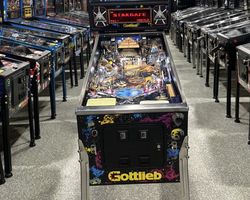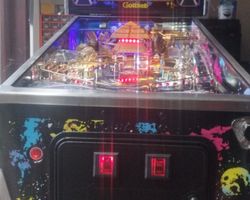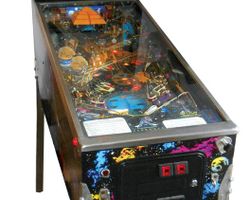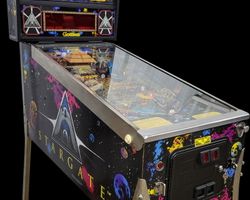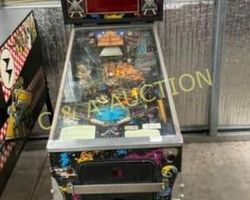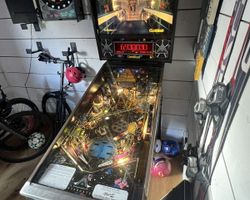Stargate
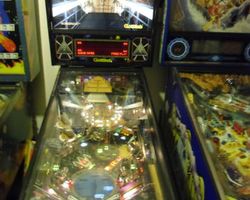
Average Prices: USD $800 to $2,400
Produced: March, 1995
Production Run: 3,600 units
Machine Type: Solid State Electronic
MPU: Gottlieb System 3
Players: 4
Design by: Ray Tanzer, Jon Norris
Art by: Constantino Mitchell
Dots/Animation by: Alycen Hareas, Vecennia Jordan, Rand Paulin
Mechanics by: Marion Czyz, Wesley Chang
Sound by: Craig Beierwaltes, Duane Decker
Software by: Allen Edwall
Stargate, a solid-state electronic pinball machine released by D. Gottlieb & Co. in March 1995, transported players into an interdimensional journey inspired by the popular 1994 film. Produced under the Premier Technology brand, Stargate represented a significant release in Gottlieb's System 3 era, showcasing the company’s ambition to integrate cinematic storytelling with interactive pinball mechanics. With a production run of 3,600 units, model number 742 was designed to captivate a broad audience, from casual players to dedicated collectors, with its licensed science fiction and Egyptian mythology theme.
The machine's creation involved a collaborative effort from Gottlieb's design and engineering teams. The fundamental game design was conceptualized by Jon Norris and Ray Tanzer, who crafted the playfield layout and core rule structure. The visual identity of Stargate was largely shaped by artist Constantino Mitchell, responsible for the vibrant backglass, cabinet art, and a significant portion of the playfield and plastics. David Moore contributed to a smaller segment of the playfield artwork, with Jeanine Mitchell providing color art. The auditory experience was developed by Duane Decker, who composed the music, and Craig Beierwaltes, who handled the sound design. Software development fell to Allen Edwall, while the captivating display animations were brought to life by Alycen Hareas, Rand Paulin, and Vecennia Jordan. Marion Czyz and Wesley Chang were instrumental in the mechanical engineering of the machine's unique features. An interesting historical note from the development process includes the existence of a prototype whitewood that featured a small, recessed mini-playfield with a ball kicker but no flipper, showcasing early design explorations that ultimately did not make it into the final production model. The game's marketing slogan, "Transport yourself to another dimension," encapsulated its thematic promise.
Signature Features and Design
Stargate distinguishes itself with several unique mechanical features that contribute to its immersive gameplay. The most prominent is the "Pyramid" situated at the top of the playfield. This detailed toy features a top section that mechanically raises and lowers, simulating the opening of the Stargate portal. Once open, a motorized "Glidercraft" ship extends from within the pyramid. This Glidercraft is not merely static; it actively zigs and zags horizontally across a 90-degree arc in front of the pyramid, presenting a moving target and adding a dynamic visual element.
Another innovation are the "Horus" targets. Unlike conventional drop targets, these targets rise into the air when activated. Each target is integrated into a larger "Horus" structure, which pivots to raise or lower, occasionally blocking access to two crucial shots. The game strategically raises these targets at specific moments, providing temporary access to the shots behind them. These features combine to create a visually engaging and mechanically diverse experience, enhancing both the challenge and the spectacle of the game. The mirrored backglass, illuminated by ring lights, further enhances the machine’s aesthetic appeal, drawing players into the Stargate universe.
Playfield and Mechanics
The Stargate playfield is designed with a thoughtful flow and an array of interactive elements. It features a triple flipper setup, with two at the standard bottom position and a third flipper positioned mid-playfield, facilitating complex shot combinations. Two steep ramps provide satisfying shots, with the right ramp feeding the upper flipper for potential repeat shots and combos. Six standard drop targets are strategically placed, complementing the more dynamic Horus targets. The playfield also incorporates two pop bumpers, central to the action, often redirecting the ball towards key shot opportunities.
The lower section of the playfield, while dense with targets and features, maintains a good flow where successful shots often return the ball directly to the flippers, allowing for continuous play. The artistry of Constantino Mitchell permeates the playfield, with detailed depictions of characters, symbols, and spacecraft from the Stargate universe. While the artwork is generally well-received, some original lighting choices can render parts of the playfield somewhat dark, which can be improved through modern illumination upgrades. The integration of the Glidercraft and the rising Horus targets adds verticality and unpredictability to the playfield, compelling players to adapt their shot strategies as these elements dynamically change the shot landscape. The game offers both a manual plunger for skill shots and an automatic launcher for faster play, catering to different player preferences.
Gameplay Dynamics
Stargate's gameplay is characterized by a deep ruleset and innovative multi-ball mechanics. The primary objective revolves around activating and progressing through various movie-themed modes, ultimately striving to reach the three distinct Wizard modes: Eye of Ra, Stargate, and Sandstorm. Progression involves hitting specific shots and targets to light mode starts and advance objectives, providing a structured yet challenging experience.
A unique aspect of Stargate is its multi-ball implementation. While it supports a four-ball multi-ball, players typically initiate with only two balls. To reach a three-ball multi-ball, players must hit a jackpot shot. This sequence can be repeated in certain modes, allowing players to earn a fourth ball by hitting another jackpot. This tiered multi-ball progression adds a strategic layer, encouraging players to hit specific targets to extend their multi-ball play rather than simply collecting all balls at once. The "Kickback" feature in the left outlane provides a crucial save mechanism, offering players a chance to recover from an otherwise lost ball. The game's scoring system rewards precision and mode completion, with significant points awarded for advancing through the narrative-driven objectives. The presence of numerous shots and a multitude of modes ensures that gameplay remains engaging over extended sessions, often leading to an "addictive" quality, even if some players find the frequency of multi-balls can make the game feel accessible.
Reception and Legacy
Stargate has garnered a highly positive reception within the pinball community, frequently being described as a "hidden gem" and a machine that offers substantial value for its price point. Many enthusiasts consider it to be among the strongest titles produced by Gottlieb, often cited as the company's best work. Its strengths lie in its deep and innovative ruleset, offering a wealth of modes and shot opportunities that contribute to a lasting appeal in a collection. The machine’s flow is widely praised, with well-designed ramps and shot returns that maintain ball control and momentum. The unique mechanical features, particularly the dynamic Glidercraft and the rising Horus targets, are consistently highlighted as standout elements that set Stargate apart. The backglass artwork is frequently lauded for its aesthetic appeal.
Despite its many merits, Stargate does have a few points of contention. The most common criticism revolves around the audio, specifically the repetitive callouts, with "Shoot the Pyramid" being a frequent complaint. Some players also note that the original sound design could have incorporated more music directly from the Stargate film. Furthermore, the factory lighting scheme on the playfield is sometimes perceived as dim, though this is often rectified by owners through LED modifications. Playfield wear, particularly in the outlane areas, is another concern mentioned by some collectors, indicating areas that may require attention over time. Additionally, a minor segment of players feels that the frequent multi-balls, while exciting, can make the game feel somewhat "easy" at times. Regardless of these points, Stargate's unique design elements, engaging gameplay, and solid build quality have cemented its reputation as a memorable and sought-after machine, standing as a significant late-era Gottlieb release.
Sponsored Links
 Ebay Listings
Ebay Listings
 Auction Results
Auction Results
| Cost | Location | Date |
|---|---|---|
| USD $5,499 |  California, United States California, United States |
08 December, 2025 |
| USD $3,000 |  Virginia, United States Virginia, United States |
06 November, 2025 |
| USD $5,499 |  California, United States California, United States |
20 September, 2025 |
| EUR €4,950 |  Baden-Württemberg, Germany Baden-Württemberg, Germany |
18 August, 2025 |
| USD $3,999 |  Illinois, United States Illinois, United States |
25 November, 2024 |
| USD $3,400 |  Georgia, United States Georgia, United States |
24 August, 2024 |
| USD $3,500 |  Virginia, United States Virginia, United States |
03 July, 2024 |
| USD $2,500 |  California, United States California, United States |
11 December, 2023 |
| USD $4,000 |  Florida, United States Florida, United States |
27 November, 2023 |
| GBP £2,159 |  Mitcham, United Kingdom Mitcham, United Kingdom |
29 October, 2023 |


Private Policy · Search Website · Contact Us
As an eBay Partner, we may earn a commission from qualifying purchases made through links on this site, at no additional cost to you.
All trademarks and copyrighted materials remain property of their respective owners. All other content copyright 2007 - 2026 Pinpedia.

